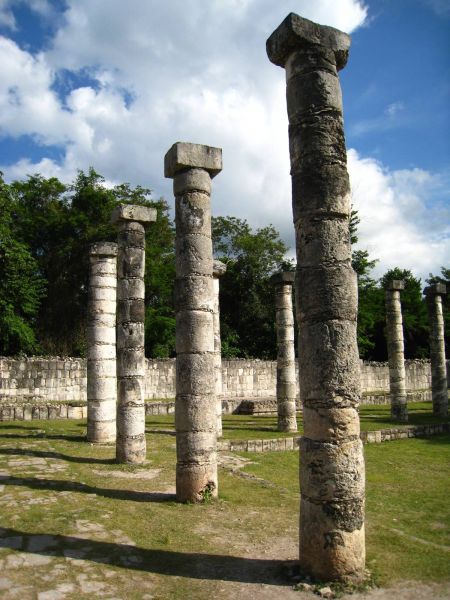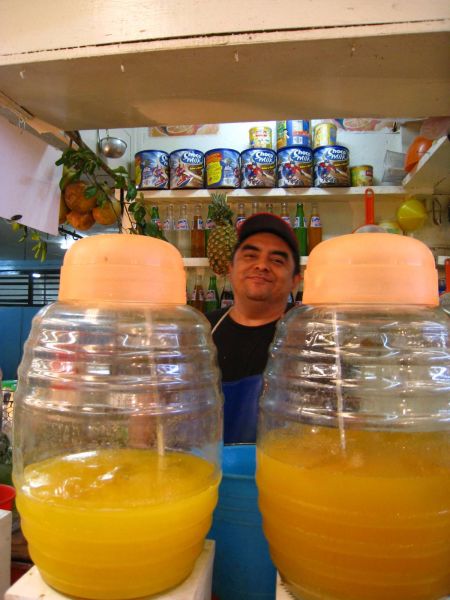
the New Seven Wonders Foundation, created in order to elect the 7 new wonders of the world, announced the verdict. A nice way to give an inheritance to the 7 glorious wonders of the Antiquity whose Egypt pyramids are the only one standing among them. Despite the entire subjectivity of the final list and the criticism dealing with the reliability of the Internet voting, the 7 new candidates were made public the 7 of July 2007 (7/7/7) and Chichen Itza hanged its name in the ranking. Without waiting for this kind of operation, the Yucatan state had already dressed up one of the spearheads of its Mayan collection to get it as attractive as possible to the tourists from all over the world.
As we pass through the entrance, everything is well presented, neatly-cut grass, pruned trees and well-marked-out path which opens out on El Castillo. This several-storey perfectly-preserved pyramid represents the Mayan calendar. On each one of its 4 sides, a staircase rises like the 4 seasons or the 4 directions. Each staircase is equipped with 91 steps, if moreover we take into account the top slab, the number of steps adds up to 365, like the number of days in a calendar year. Mayan people were clever astronomers and made coincide the orientation of El Castillo with the position of the sun in the sky. So much so that for the spring and autumn equinoxes, the tourists mass on the lawns of the park to observe an optical illusion. That day, the suns draws a snake which seems to crawl up the steps. To us, it's not the good day but the architectural harmony is enough to delight us. We walk around the pyramid and each new meter offers a different and splendid view of the building. Our eyes follow the geometrical lines shaped by the stone. We live this kind of feelings which is worth the trip only to see it. Me move away to visit the other ruins that scatter around with the warriors temple, the observatory, the thousand-column group and the gigantic ball game where according to the legend, the captain of the losing team offered his life into a human sacrifice the Mayan deities claimed.



























To get over the feelings of Chichen Itza, we go to discover the colonial city of Merida. A place not necessarily restful but that has the merit or the inconvenient to be located between 2 Mayan sites. And without staying for ages downtown, we leave Merida the next day to the radiant city of Uxmal.






Keyword - thought -
Friday 14 November 2008
in front of the great pyramid of Chichen Itza
By dorian on Friday 14 November 2008, 13:50 - RTW2-Mexico
Monday 3 November 2008
into the stars on the Mauna Kea
By dorian on Monday 3 November 2008, 08:31 - RTW2-Hawaii

Two 4000-meter-plus peaks, the Mauna Loa and the Mauna Kea, breakthrough the milk-white expanse of clouds which invariably covers the afternoons of Big Island. A road makes its way through the two giants, we travel it for several dozens of kilometers then turn off to the right and rise on the slopes of the Mauna Kea. The vegetation vanishes, a low-growing and crimson grass takes place and wraps the stone-free areas. We close our windows, the cold makes our skin tingle. But the temperatures aren't wintry yet when a layer of snow strews the heights of the volcano.
The purity of the sky attracts worldwide astronomers and a flock of white- or silvery-domed metallic mushrooms thrusts up on the top. These observatories and telescopes use the latest technologies to attempt to fathom out the stars and other luminous and radio-electrical manifestations. We park near the largest telescope in the world. The surrounding ocean of clouds doesn't take long to soak up ochre shades and we remain silent in front of the sun which slowly disappears on the horizon.
When the night is dark enough, halfway up the hill, a group of amateur or professional astronomers give us explanations about the starry vault. Electronically-controlled portable telescopes point at remarkable objects such as galaxies or cosmic clouds. An informal and educational encounter between a group of enthusiasts and a handful of tourist eager for understanding a little bit more of what happens overhead.










Saturday 11 October 2008
the underwater junkyard of Million Dollar Point
By dorian on Saturday 11 October 2008, 09:12 - RTW2-Vanuatu
With the signing of the armistice proclaiming the end of World War II, the Americans were in a hurry to go back home. The world from now on went in peace, they found themselves with a set of useless not to say cumbersome military equipments. In the middle of a beach, east from Luganville, they built a bridge then brought trucks, cranes and jeeps and jettisoned them. Before definitively going home, they exploded the bridge leaving a submarine junkyard behind them, the « Million Dollar Point ». And nowadays, we can dive on this heap of concretion-covered scrap iron. This time, a weird, off-the-beaten-track dive.













« previous entries - page 1 of 2





